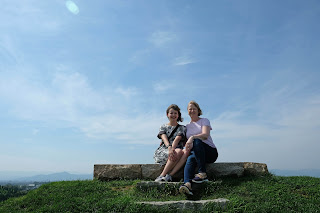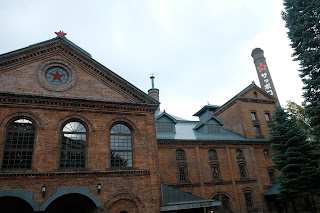My mom, who came out for a long weekend, and I decided to spend a few days in Sapporo, the capital city of Hokkaido. We found some fairly inexpensive flights, booked a hotel, and thought the matter done and dusted. But only a few days after making all our arrangements, Hokkaido was rocked by a magnitude 6.7 earthquake that left at least 30 people dead and the entire island without power or water for several days. But after carefully monitoring the situation, and checking-in with the local U.S. consulate, we decided that the trip would still be a "go."
We got into the city from New Chitose Airport without any problems. The next day, since the weather decided to cooperate, we headed out to Moerenuma Park, a former landfill converted into a municipal park by noted architect and artist Isamu Noguchi. (Fun fact: he has a Yale connection! He designed "The Garden" in the Beinecke plaza!)
Moerenuma Park might have been a bit of a pain to get to (involving a train and then a bus that only came once an hour), but it was amazing. No description can really do it justice: the play between man-made and natural formations, of geometry, geography, materials, and perspective are just mind-blowing.
So here are just a bunch of photos:
Other travel highlights included wandering through the section of Odori Park not congested with Sapporo's food-themed Fall Fest...
 |
| The Sapporo TV Tower! |
...catching the tail-end of a Japanese-Russian (we think) wedding at Hokkaido Shrine...
 |
| The funniest thing was watching other tourists take photos "with" the wedding party! |
 |
| Each fisherman worked for three months, April-June and rented one single tatami mat, where they slept. There were two rows of 25 men in this house, all living together. |
 |
| The women who cooked and cleaned for them slept in this isolated second-floor room. The ladder would be pulled up after them at night to prevent them from being assaulted. |
 |
| This is a native Hokkaido pony named Riki (which means "power") who pulls a little replica streetcar! |
...and drink-- I mean learning about!-- beer at the Sapporo Beer Museum.
Our two days in Sapporo flew by, filled as they were with excellent company (hi, Mom!), amazing sights, and delicious food/coffee. All-in-all, I would love to visit again to check out some of the sights that couldn't fit into our too-short trip, and hopefully find a way to see more of the lush Hokkaido countryside.
Till next time, Sapporo!























Comments
Post a Comment